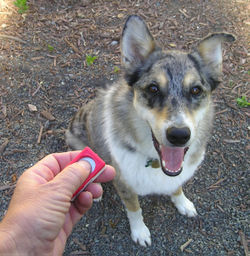
| What is Clicker Training? |
By Lynne Hand |
The clicker is usually a small plastic gadget with a button on top of it which makes a clicking sound once it is pressed. Research has shown in many studies that the clicker promotes obedience training without the use of harsh discipline or negative reinforcement. The idea behind clicker training is that whenever your dog does something positive, they'll get rewarded and continue to behave in that manner. One of the challenges in training any animal is communicating exactly when they have done what you are attempting to reinforce. As a simple example, consider teaching a dog to back up. At the instant that the dog moves backwards, the trainer must let the dog know that it has done the correct thing. However, the traditional "good dog!" takes so long to say that they might already have moved on to some other behaviour. By the time the dog realizes it is being praised, it might be moving forward again, or even sitting and scratching. Dogs are extremely intelligent and if they do something that earns them praise or a tasty treat, they'll quickly learn to repeat the action. The first step in clicker training is to teach your dog that the clicker sound means that they will get a reward. To my dog it is the promise of a treat. To do this, you need to set the rules by "charging" or "loading" the clicker. In the beginning you click the clicker and simultaneously give the reward, usually an unaccustomed, tasty treat, one small enough to be consumed almost instantly. Dogs often learn the association in one session, with as few as five to 10 repetitions. You can test your progress by waiting until the dog's attention is elsewhere and then clicking. If your dog immediately looks toward you as though expecting a reward, it is likely that they have made the association. That said, a clicker should only be used to reinforce positive behaviour, and not to get your dogs attention if it's misbehaving, or all your hard work will be undone in the "click of a clicker". If your dog obeys you by following your "sit" command, simply "click" immediately - timing is very important - and then reward with a treat. The next time they obey, do the same, don’t say anything verbally, your dogs will soon realize that whenever they sit, they'll hear a "click" and get a treat. This is powerful because your dog will associate the clicking sound with positive reinforcement and over time you may be able to start delaying the treat, which can cut down on the number of treats you have to give, some dogs even learn to obey without the treat, just the clicker. |
 A very popular "positive" training method is "clicker training". It is the process of training an animal using a conditioned reinforcer, which indicates to the animal ("marks") the precise behaviour that was correct. It was originally used in training animals such as dolphins and pigeons, for which traditional methods of obedience training aren't useful. Although it is a form of operant conditioning, the more popular name "clicker training" comes from the fact that the conditioned reinforcer used by many dog trainers is a small mechanical noisemaker called a "clicker".
A very popular "positive" training method is "clicker training". It is the process of training an animal using a conditioned reinforcer, which indicates to the animal ("marks") the precise behaviour that was correct. It was originally used in training animals such as dolphins and pigeons, for which traditional methods of obedience training aren't useful. Although it is a form of operant conditioning, the more popular name "clicker training" comes from the fact that the conditioned reinforcer used by many dog trainers is a small mechanical noisemaker called a "clicker".